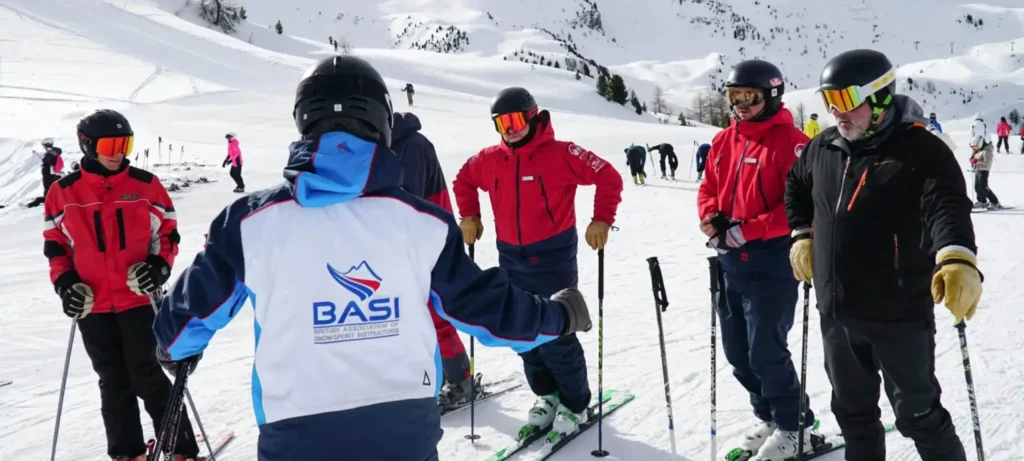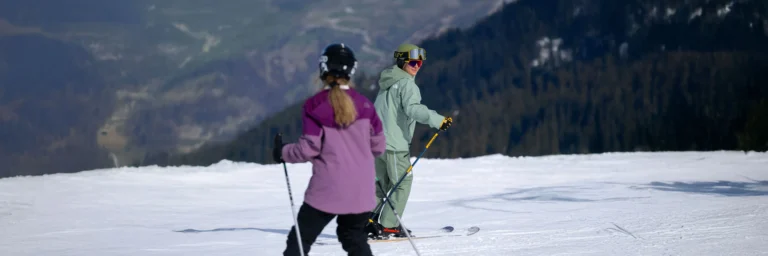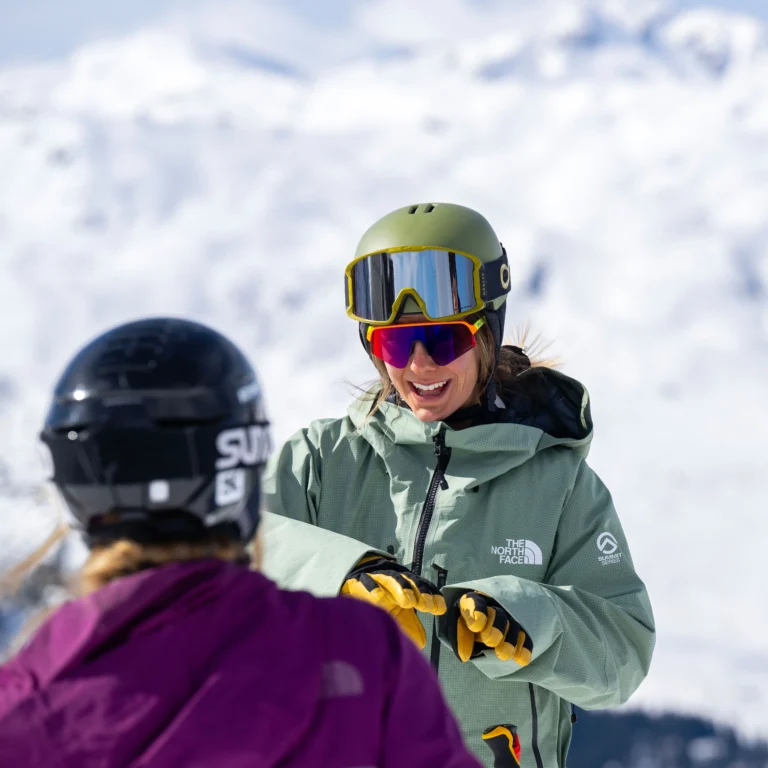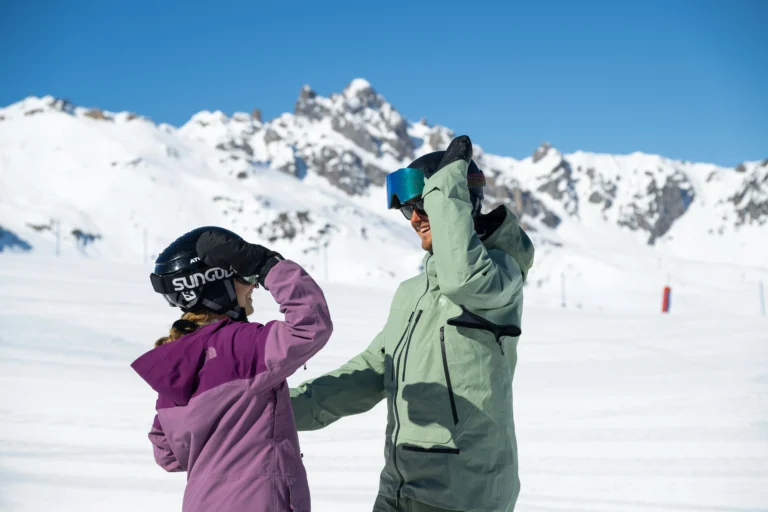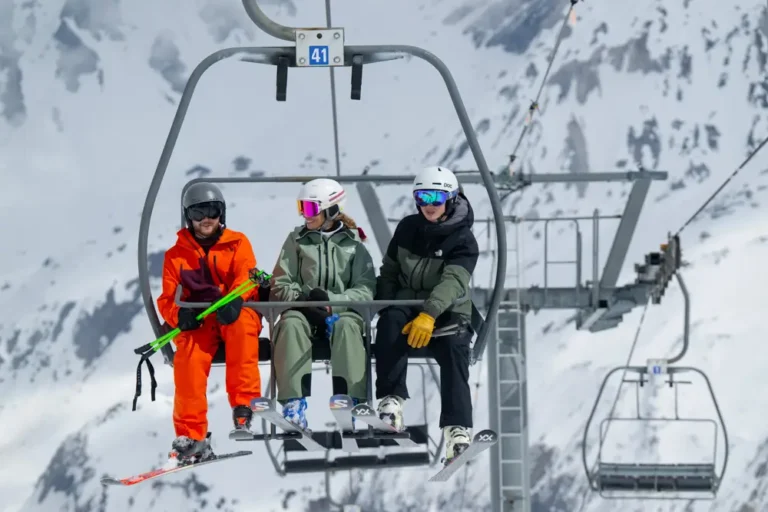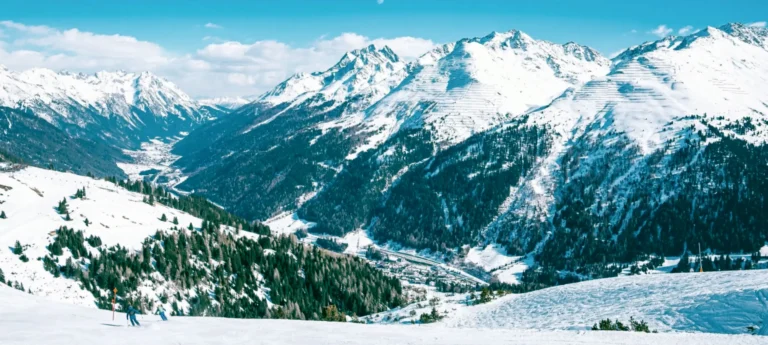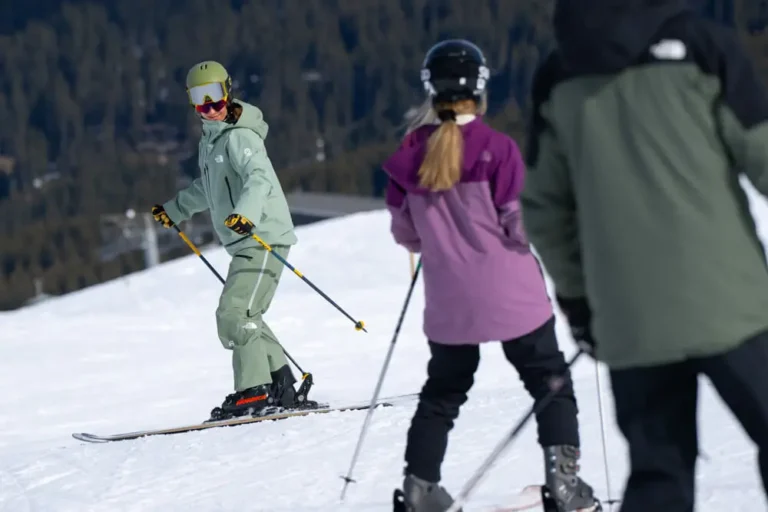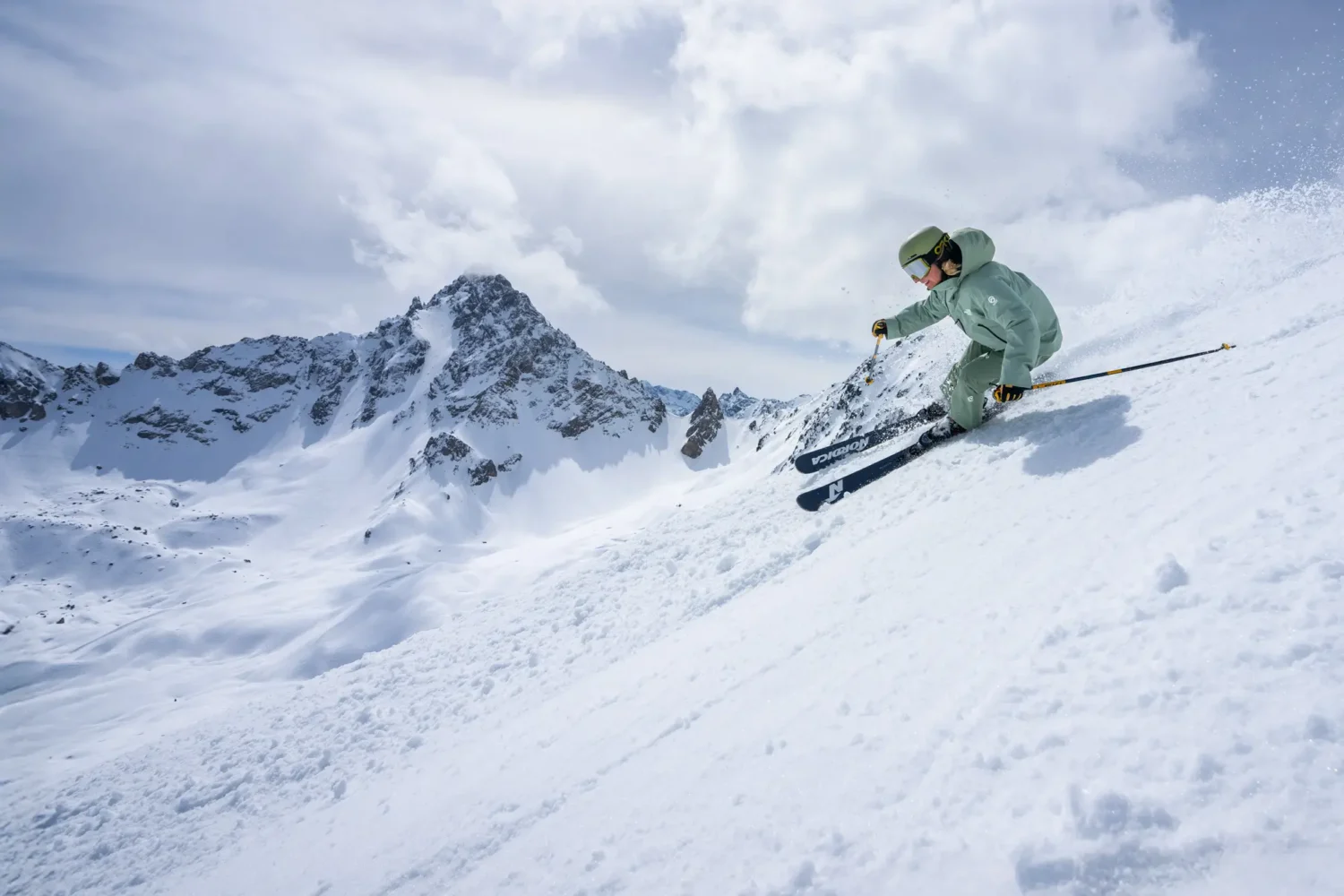Here’s our guide to the most common failure areas where people struggle with their BASI Level 2 and how best to fix them.
These guides should hopefully give you areas to focus on ahead of your BASI Level 2.
Short turns
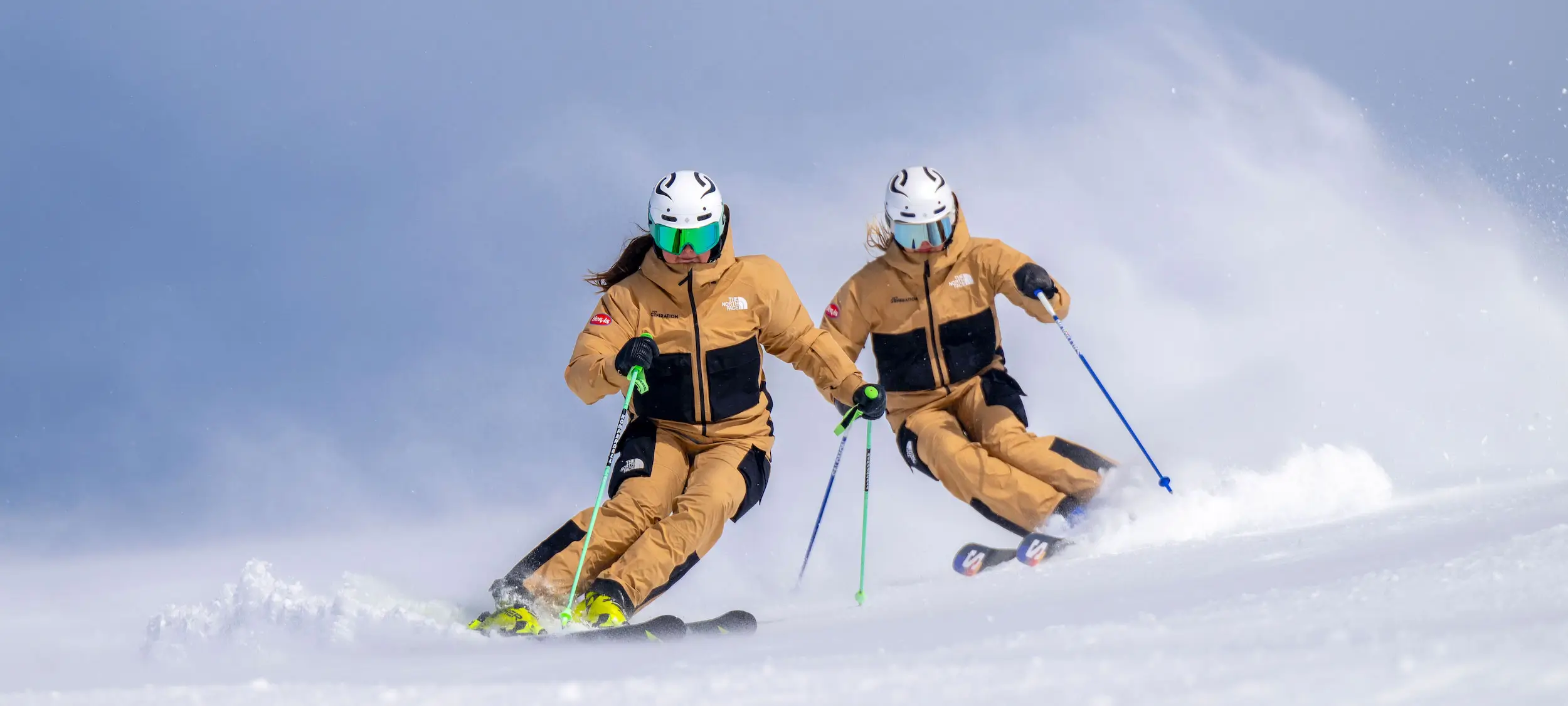
- Perform grippy turns from the fall line. These turns should be round, symmetrical, short turns, in various corridors on a blue or easy red piste.
- Show the ability to maintain a constant speed.
- Use effective posture, balance and movements.
Most people struggle with ineffective posture and balance. Tactical changes, such as adjusting the corridor, are easier to make, but technical changes can prove more challenging.
One of the most difficult technical challenges is maintaining lateral and rotational separation. A solid pole plant is crucial for success in both areas.
You can work on your separation with a series of drills. For rotational separation, look to keep the outside ski on the ground while the inside ski is lifted. Keep the lifted ski tip pointing down the mountain while the outside ski turns underneath the inside ski. You should feel the separation at your waist as you move through the turn. You should then repeat with the other ski. Be careful not to put the ski down on top of the other.
This drill can work for different turn sizes, but it is best for short turns.
One tactical approach is to increase the corridor of your short turns. This should give you more time and space to fully separate. Work from here and get narrower with your corridor until you’re comfortable with both.
Long turns
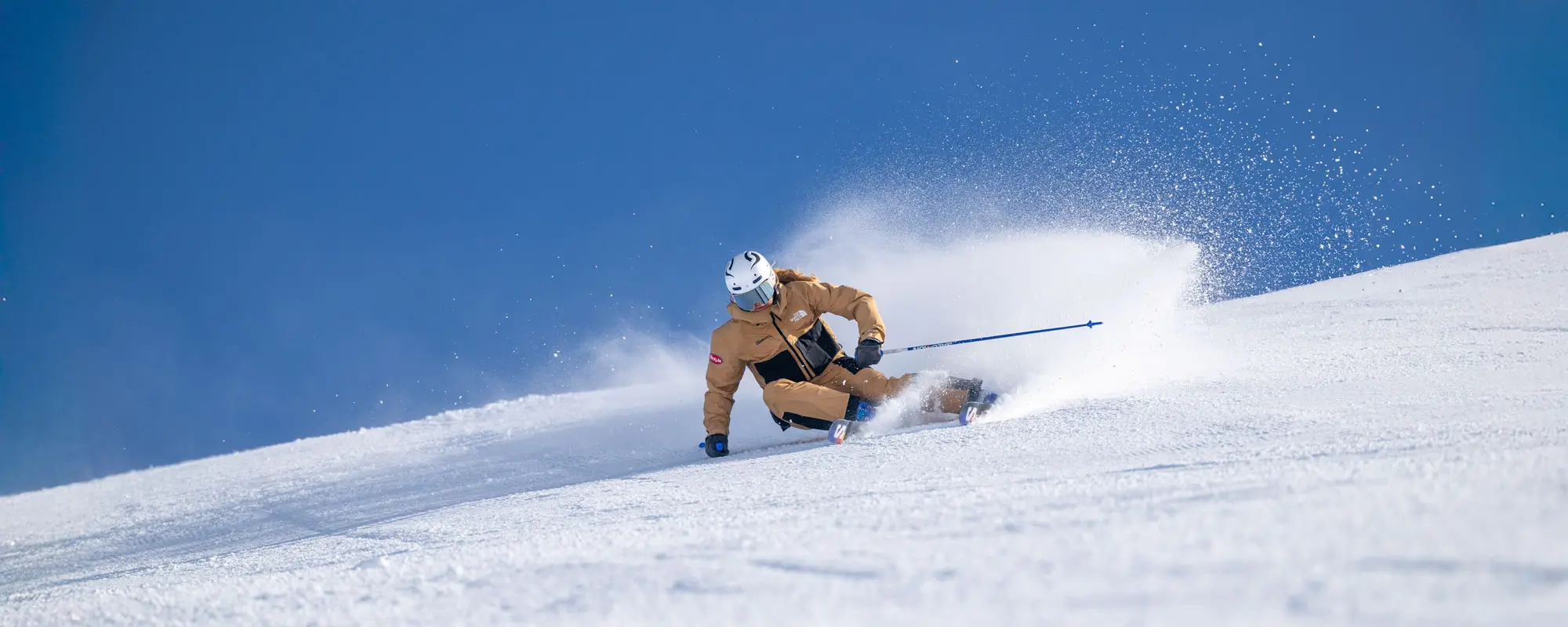
Long turns are one of the strands that you’ll be most closely assessed on. Your examiner will ask you to.
- Perform cleanly carved turns on a blue piste
- Show a variety of turn radii
- Use effective posture, balance and movements
The BASI examiner will look for telltale signs that your long turns meet their criteria. Carved turns will leave two clean lines in the snow.
A common key failure point is when skiers are on their inside ski.
Skiing on your inside ski will mean you aren’t using effective posture and balance. When this happens, your outside ski may also break away, preventing you from carving cleanly. To stay on your outside ski, stand on it early. Laterally separate as much as possible through the turn to prevent this.
Don’t worry too much about going for maximum edge angle. If you aren’t laterally separating enough, you can fall inside.
When laterally separating, you should feel a pinch in your hip.
A great way to get this feeling is to practise starting the turn on the uphill ski with the downhill ski lifted. As the uphill ski becomes the outside ski, aim the bring your elbow towards your hip. This will keep your centre of mass over the outside ski. You can keep the tip of your lifted ski on the ground to help you balance. During the transition, swap legs and repeat.
This drill helps you apply early outside pressure to your ski and gain the feeling of lateral separation.
Steeps
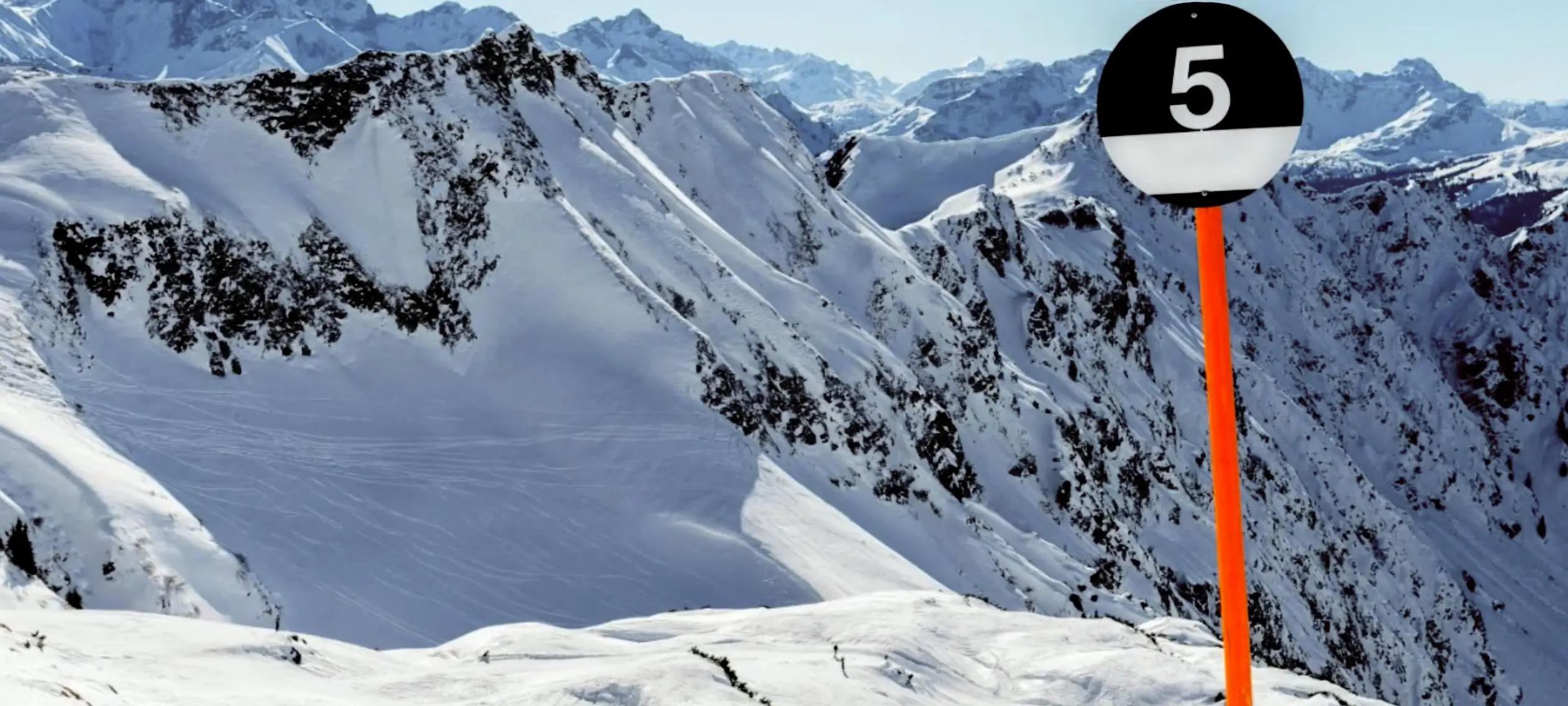
Steeps are one of the simpler strands. Your examiner will ask you to do the following on a groomed black slope.
- Perform linked turns on a steep red or black piste
- Show the ability to control speed safely
- Use effective posture, balance and movements
The steepness of the slope and the need to control speed can cause skiers to skid their turns too much. This will cause the skier to move down the slope with their skis pointing across the slope. This would mean they’re not demonstrating linked turns. Aim to bring maximum ski rotation and edge angle to the mid-part of the turn rather than dumping it all at the end. Rotational separation can prevent you from getting stuck at the end of the turn. This will also help you to link your turns.
Freestyle
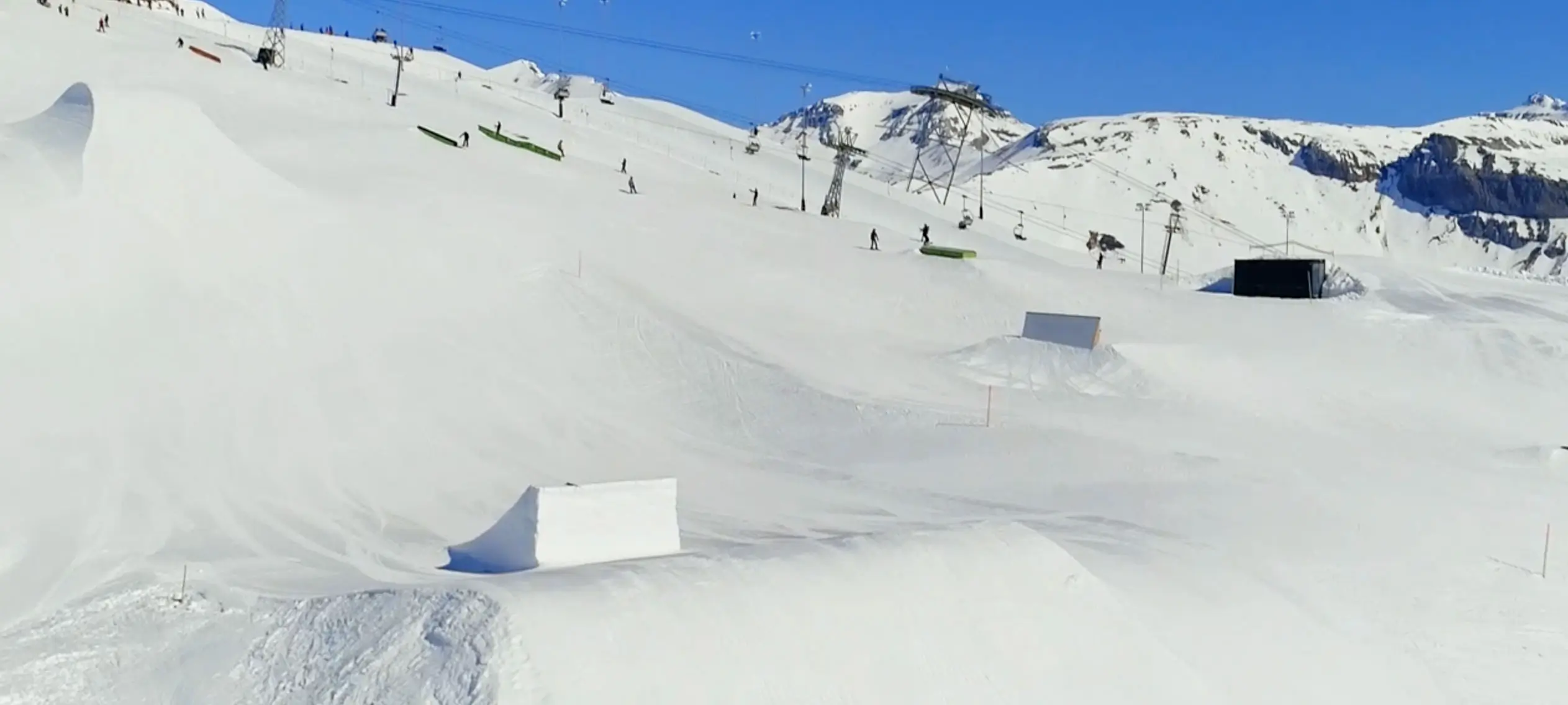
Freestyle can feel unusual to those who haven’t spent much time doing it. Fortunately, compared to the other strands, the criteria are fairly simple.
You’ll be asked to do the following.
- Perform a small, safe jump with a balanced landing off an appropriate side hit or natural feature.
- Ski switch safely on an easy blue run, showing parallel skis for at least 2/3’s with smooth transitions.
- Perform a small, safe jump with a balanced landing off an appropriate side hit or natural feature.
- Adjust basic posture, balance and movements as required to demonstrate basic flatland tricks.
- Ski consistently at safe speeds in beginner freestyle terrain.
Skiing switch causes the most problems on this strand. You’re required to ski switch with a smooth transition for two-thirds of the run. Students may want to step their skis around or go into a plough too early in the turn. To fix this, the student should make their turns longer. The alien feeling of skiing switch may lead the student to rush the turn and complete it in too small an area. Choosing slightly larger turns will give you more time to get your skis around.
Variables
When skiing, the Variables your examiner will look for:
- Rounded, linked turns on a blue or red steepness slope in various conditions.
- A variety of turn radii.
- Effective posture, balance and movements.
When skiing variables, you’ll still need to maintain a high level of performance. This will be more difficult on chopped-up terrain, which will throw you around more than the equivalent on piste turns. Maintaining effective posture and balance is the most difficult part of this strand.
Focus on having a solid core to help with this. Skiing variables mean that it’s almost inevitable that you’ll get thrown around. The key to success is recovery. You should also aim to ski with a slightly narrower stance than you would on piste.
Ideally, you’ll want your skis to go through similar snow. The closer together they are, the more similar the snow they’ll contact. Along with a slightly narrower stance, you may also want to ski more two-footed. This is where you’ll balance the pressure between the two skis more equally. Over-presurising a single ski in soft snow will cause it to sink. Once it has sunk, the following rotation of the ski will cause the skier to fall.
Bumps
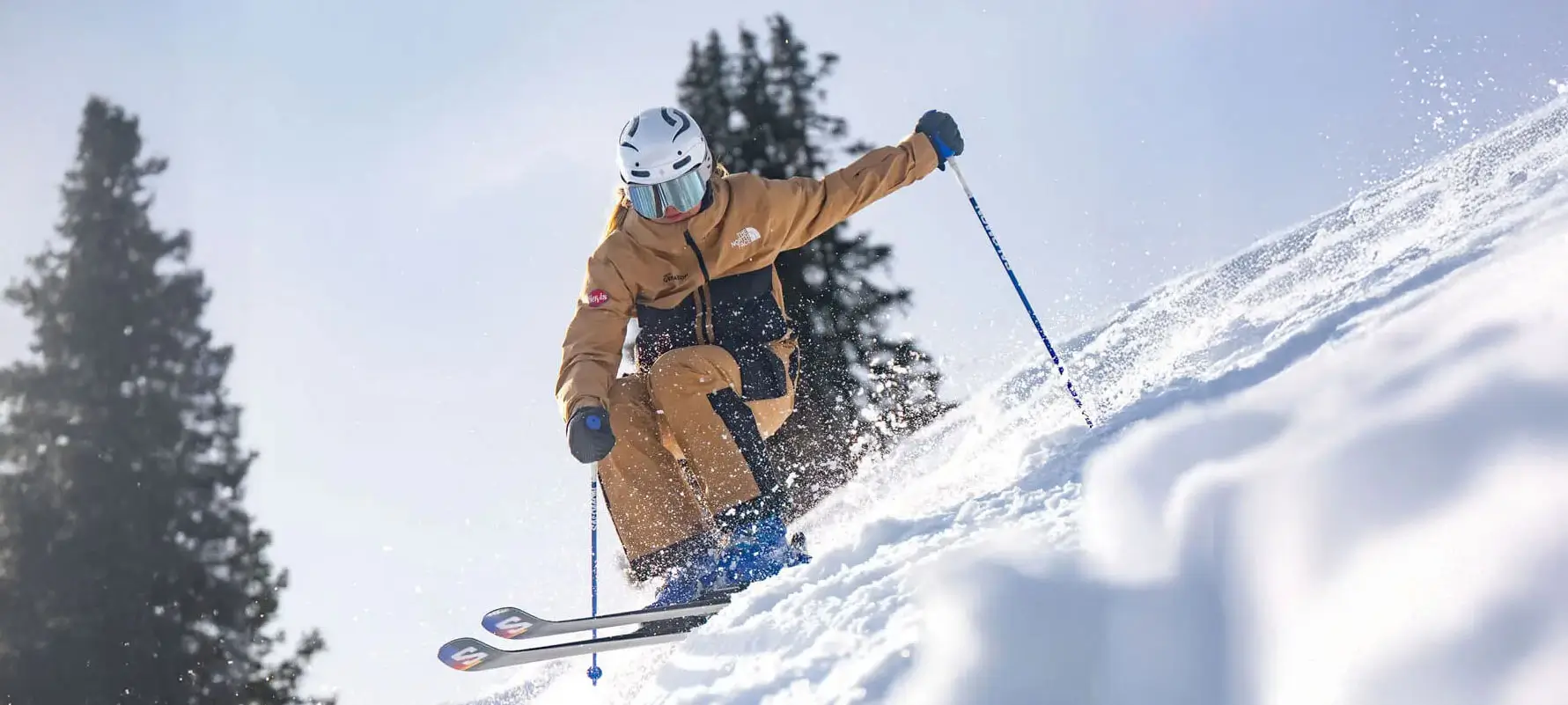
You’ll have to do the following during the bumps section of your BASI Level 2 assessment.
- Perform continuous, linked, skidded turns in easy bumps
- Show the ability to stay in a narrow corridor
- Maintain a constant speed
- Use effective posture, balance and movements
Staying in a narrow corridor at a continuous speed can be difficult for many skiers.
A narrow corridor can lead to skiers speeding up uncontrollably. To remedy this, they will often erroniously skid their turns excessively and late to create a stop on top of each bump. This means the skier can’t maintain a constant speed or perform linked turns.
An uncontrollable increase in speed will occur when the skier doesn’t have adequate flexion and extension, or a strong pole plant.
Central Theme
- Choose terrain that is appropriate for the level of the Central Theme.
- Perform Central Theme as described in the BASI Alpine manual.
The central theme is highly dependent on being accurate. Being inaccurate with your movements is often what trips students up.
Slow down your movements. Trying to do the central theme too quickly may create movement inaccuracy. One of the more difficult sections of Central Theme is plough parallel. The peddling movement in particular can be hard to get right. Exaggerating the movements can help you get the feeling of peddling. Make sure you time this motion to stand on the new ski before the fall line. You must stand on the ski rather than pushing it away from you.
Teaching
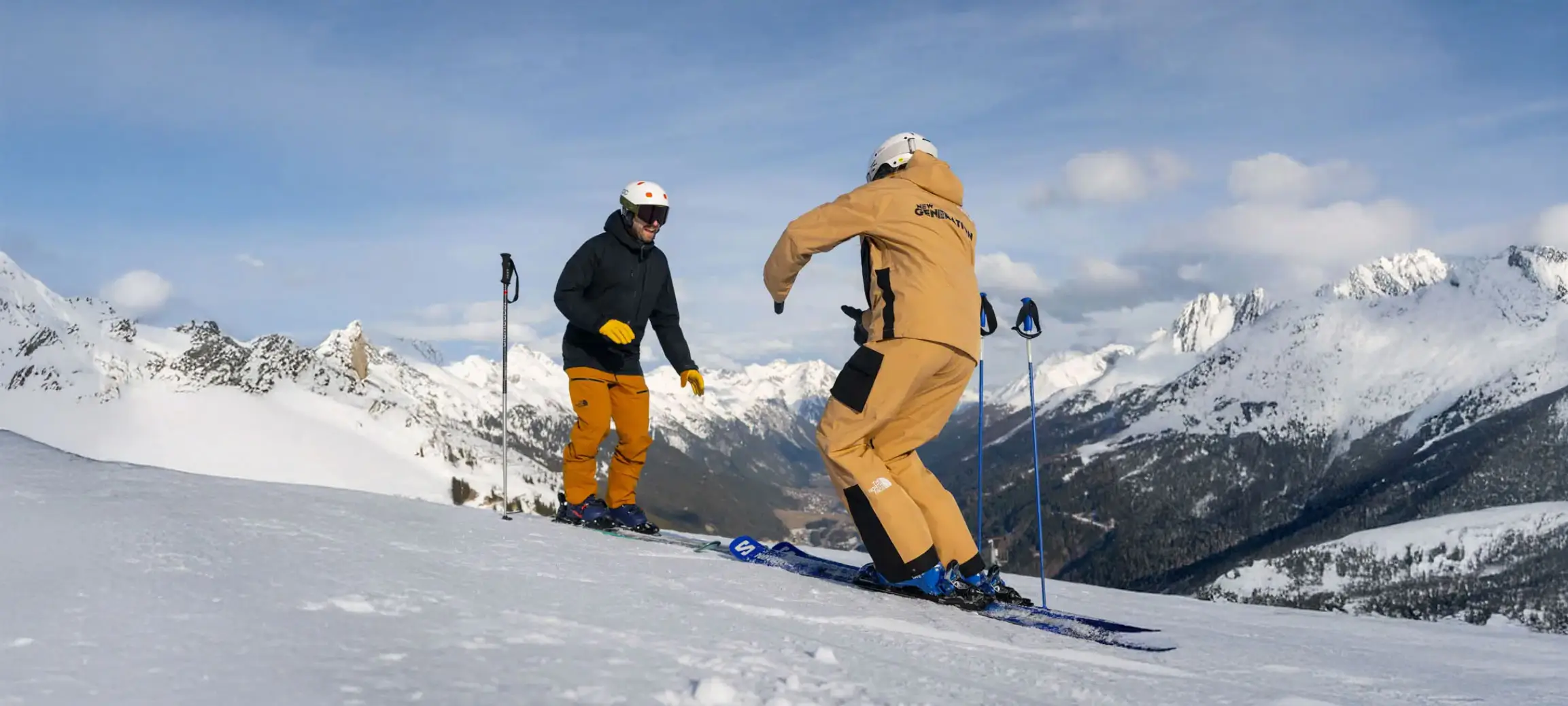
The BASI Level 2 assessment includes a teaching section.
Compared to the skiing strands, it’s more difficult to train for. The unfamiliarity of ski teaching can cause you to overthink many aspects of teaching. BASI examiners will be looking for you to deliver a safe teaching session. Always think of the terrain and other skiers to make a session safe.
A common mistake I saw during my BASI Level 2 was stopping in the middle of the piste. You should always stop on the side of the piste. Try to convey the importance of safety to those in your class. Remind them to look for other skiers when setting off for their run.
During your teaching session, don’t get distracted by the technical aspects. This always comes after the safety part. Take your session at a steady pace. Remind yourself of different safety principles when you’re on the lift.
If you get caught out, it’s much better to readjust your session. Don’t be afraid to move the group to a new area. It’s better to do this than have your BASI examiner remind you.
